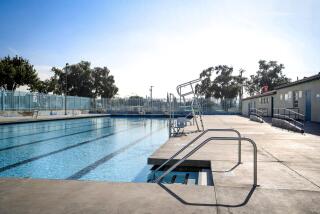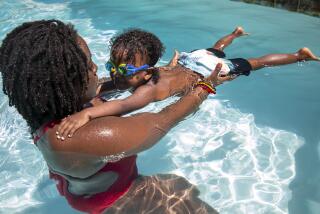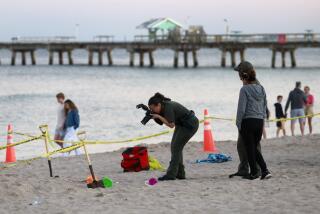A CLEAR & PRESENT DANGER
- Share via
Mary Glass had an idyllic life: a happy marriage, four children, a senior position with a mortgage company and a beautiful Mission Viejo home with a pool and spa in the backyard.
But it changed on one Sunday afternoon in April 1991.
Glass was upstairs putting away laundry while her 20-month-old son, Crissy, tagged along. Downstairs and in back, friends and relatives were preparing for a barbecue.
Crissy wanted to join the group, so Glass watched as her son turned on his stomach and slid down the stairs feet first. She would follow in a minute.
After filling one more drawer, Glass headed downstairs before learning her other son needed a fresh shirt. She got it, then checked for Crissy.
When he wasn’t immediately visible, she called outside to her husband, who was barbecuing near the pool. As their eyes scanned the yard, they were stunned by a horrible sight: their son’s body at the bottom of the spa.
About 300 children ages 1 to 5 die each year in home swimming pools and spas in the United States, and California, with 1.1 million pools and 1.2 million spas, leads the way.
Drowning is the leading cause of accidental death for California children 5 and younger.
In 1995, the most recent year for which statewide statistics are available, 59 children 5 and younger drowned.
In Los Angeles and Orange counties last year, 28 children drowned in pools and spas. And for every drowning victim, there is a person who suffers permanent brain damage after nearly drowning.
And yet, the majority of homeowners fail to take precautions--including the installation of four-sided fences, safety pool covers and alarms on doors leading to the pool--that could prevent the tragedies.
“The pool environment lures people into a sense of security because it’s at home, where we tend to let our guard down,” said Capt. Scott Brown, chief spokesman for the Orange County Fire Authority.
In partnership with Children’s Hospital of Orange County, the fire authority is sponsoring a public education campaign in response to what Brown calls an “epidemic” of Orange County drownings in 1996 (12 children died; that’s about how many are in a preschool class, Brown noted).
Brown and others in the drowning-prevention field are trying to dispel several common myths:
* The first is that most toddler drownings occur when the child is playing in or near the pool, unsupervised.
Actually, in most cases the child was last seen doing something safe, like napping, watching TV or playing inside.
“These children are curious and learning new things everyday,” said Mary Marlin, community education manager for Children’s Hospital of Orange County. “Their job is to explore, and unfortunately they are not verbal about their exploration, and they aren’t necessarily aware that the pool is a hazard.”
* Another common misconception is that the drowning child will be heard, that he will splash, sputter or scream.
Typically, because small children are top heavy, they go in head first and don’t resurface.
To illustrate the point in her presentations to parents, Marlin plays what she announces to be a tape recording of a small child drowning. The tape is silent.
Given the myths, pool-safety activists cringe when they hear pool owners say that they’ll simply supervise their children, the implication being that drowning happens only to those who don’t.
After her son’s death, Mary Glass began speaking before groups of parents at every possible opportunity in an effort to convince them that supervision is not enough.
“If you think you’re the best parent in the world, you’re the one I’m talking to,” said Glass, who insists that she had always been extremely cautious, so cautious that she had never left her young children with a baby-sitter.
“Parents whose children drown or nearly drown are not bad parents,” said Billie Weiss, director of the injury and violence prevention program for the Los Angeles County Department of Health. “In point of fact, no one can supervise a child 24 hours a day.”
But what they can do, Weiss said, is install barriers, often referred to as “layers of protection,” between the child and the pool. When used properly, these barriers will either prevent children from straying into a pool or buy time until they are discovered en route.
“There is no better way to stop a drowning,” Marlin said.
The barrier widely viewed as the most effective is the four-sided fence.
Since most backyards already are fenced on three sides, this usually means adding one side to isolate the pool from the house. The fence should be at least five feet high, designed and built to be unclimbable by a toddler, with a gate that opens outward and automatically latches closed.
A second barrier is a pool cover. Most experts recommend automatic covers, because the manual devices are more difficult to maneuver and therefore less likely to be used each time the pool is unoccupied.
A third effective safety device is an alarm on doors leading to the pool area. The alarms typically come with a touch pad, placed out of the child’s reach, that enables adults to inactivate the system long enough to open and close the door.
Homes where small children live or frequently visit should have the alarms along with, rather than instead of, the four-sided fence, suggested Marcia Kerr, public affairs specialist for the U.S. Consumer Product Safety Commission. Kerr also recommends a self-closing, self-latching device on sliding glass doors.
All three safety devices--the four-sided fence, pool cover and door alarm--are listed as options in various city and county ordinances in Southern California for new pool construction, though some exclude the safety cover as an option. A new state law that will take effect Jan. 1, 1998, mandates either the four-sided fence or the door alarm.
But most of the ordinances have been adopted only recently and do not affect existing pools, meaning that compliance with safety recommendations is voluntary for the vast majority of pool owners.
“Most drownings don’t occur in new pools,” Weiss said. “When something’s relatively new, people tend to pay more attention to it. More likely, though, people will move into a home with an existing pool [that has no protective barriers] and not realize that something needs to be done right away.”
She notes that many safety advocates are now pushing for retroactive legislation. At a minimum, they would like to see financial incentives--such as low-interest loans or tax breaks--offered to entice homeowners to voluntarily comply.
To those who argue that the fences are not aesthetically pleasing, Brown has stories to relate of dead and brain-damaged children that are far uglier than any fence. To those who balk at the cost, Brown asks, “How can you put a price on a child’s life?”
“We did some cost analyses,” Weiss said. “If you put in everything you could think of to protect your pool, including the fence, automatic pool cover and door and window alarms, at most it would cost you $8,000. The average cost of a pool is $20,000. The annual cost of caring for a near-drowner with severe brain damage is about $150,000. People with young children who have a swimming pool need to consider that the cost of these safety measures is insignificant compared to what can happen to a child.”
But Kerr suspects that the real reason many pool owners don’t install safety barriers is that they aren’t convinced that they work. “They think that they can just watch their child closely,” said Kerr, whose 2-year-old son drowned in 1988 in the family pool while in the care of a nanny.
No one denies the importance of supervision, but to most parents, supervision means being aware of the child’s activities and within earshot, not necessarily watching their every move. This is why the experts recommend layers of protection that go beyond supervision.
At times when children are swimming in or playing near the pool, traditional supervision often breaks down either when parents are momentarily preoccupied and lose visual contact or when more than one adult is outside and it’s not clear who is responsible.
Brown noted that a number of drownings have occurred in the presence of adults who failed to notice until it was too late. “It can happen in seconds,” he said.
The current public education campaign in Orange County is emphasizing a “Water Watcher” program in which one person is designated to watch only the water for 10 minutes at a time when children are present and wears a tag that reads “Water Watcher.”
*
Mary Glass thought she had taken every precaution, but in retrospect she believes she could have done more. Although she had a gate on the side of the house, her son had managed to get past it; to this day Glass isn’t sure how. But a door alarm might have alerted her before he got to the gate, and someone assigned to watch the pool that day could have intervened.
Glass describes the six years since the death of her son as a living hell. A few weeks after the incident, her grief-stricken twin brother died of a massive heart attack. Glass regularly woke up screaming from nightmares. Her 4-year-old son felt the drowning had been his fault and began telling her he wanted to die.
Despite their resolve not to let the tragedy ruin their marriage, Glass and her husband filed for divorce within two years. “All you could see when you looked into each other’s eyes was pain,” she said.
As much as she can, she continues to speak to parents about her plight and cautions that it can happen to anyone. But the message doesn’t always get through.
Shortly after her brother died, Glass listed her house for sale. Before doing so, she had installed a wrought-iron fence between the house and the pool. Glass disclosed the drowning incident as part of the sale. Nonetheless, the buyer--a young pregnant woman--wanted the fence removed before the closing date.
“She said, ‘That’s not going to happen to me,’ ” Glass recalled.
For optimum safety have one person watch only the water when children are present and wear a tag that reads “Water Watcher.” Another person watches the kids. When the “Water Watcher” is relieved the tag is passed on so that it’s always clear who is responsible. Available free: (714) 532-8887.
(BEGIN TEXT OF INFOBOX / INFOGRAPHIC)
How to Set Up Protective Barriers
Here are some of the types of products that pool and spa owners can install as protective barriers:
* Fencing. Generally considered the most effective precautionary measure, fencing isolates the pool and spa on four sides.
Most backyards are already fenced on three sides, so this would involve adding a fourth between the pool and the house. The fence should be at least 5 feet high, with vertical bars that are no more than 4 inches apart. It should include a self-closing, self-latching gate (with the latch out of a child’s reach) that opens outward. It should not be climbable, and no object that could be used to aid in climbing should be nearby.
Aluminum fences generally run $25 to $30 per linear foot, wrought-iron fences $19 to $25, and nylon or polyvinyl mesh $15 to $20.
* Safety covers. Automatic covers are preferred, since they are easier to use--with a flip of the switch, the pool is covered. They should bear the approval of the American Society of Testing Materials and should not be the bubble covers that are unattached and can be dangerous.
Water that collects from rains or sprinklers should be pumped off regularly, since even a puddle poses a drowning hazard.
While automatic covers cost about $5,000 to $6,000 for a 15-by-30-foot pool, some of the cost is returned: The cover reduces the need to run the filter, change the water and add chemicals; it also can raise the temperature of the pool without the use of a heater.
* Alarms. Placed on doors and windows leading to the pool area, alarms are typically battery operated and respond when the door or window is opened without the alarm being deactivated. Touch pads that temporarily deactivate the alarm should be placed out of the reach of children. Alarms can run less than $100, plus installation.
* Infrared detection. Wireless infrared detection systems sound when an area around the perimeter of the pool is crossed. They cost about $300.
* Door closure systems. A self-closing, self-latching mechanism can be installed on sliding-glass and sliding screen doors, also for as little as $300.
Source: U.S. Consumer Product Safety Commission.
(BEGIN TEXT OF INFOBOX / INFOGRAPHIC)
Pool Precautions
* Use not one but many safety barriers, providing “layers of protection” so that if a child eludes one there are others in his or her way.
* Designate a person to watch the pool/spa area whenever children are present.
* Don’t leave toys near or floating in the pool/spa when it’s not in use. They attract small children.
* Look in the pool area first if a child is missing. When a child is immersed in water, every second counts.
* Know infant/child CPR, and make sure others who watch the child are also familiar with rescue procedures.
* Leave a cordless phone near the pool for quick access to 911 emergency service.
* Keep rescue equipment in the pool area, including a life-saving ring and shepherd’s hook.
* Make sure all safety barriers are in good working order and are used properly at all times.
* Install safety barriers even if you don’t have a small child; chances are you have grandchildren, other family members or friends with children who will visit your home. Nearly half of all children under 5 who drown do so in a home other than their own.
More to Read
Sign up for Essential California
The most important California stories and recommendations in your inbox every morning.
You may occasionally receive promotional content from the Los Angeles Times.













![Vista, California-Apri 2, 2025-Hours after undergoing dental surgery a 9-year-old girl was found unresponsive in her home, officials are investigating what caused her death. On March 18, Silvanna Moreno was placed under anesthesia for a dental surgery at Dreamtime Dentistry, a dental facility that "strive[s] to be the premier office for sedation dentistry in Vitsa, CA. (Google Maps)](https://ca-times.brightspotcdn.com/dims4/default/07a58b2/2147483647/strip/true/crop/2016x1344+29+0/resize/840x560!/quality/75/?url=https%3A%2F%2Fcalifornia-times-brightspot.s3.amazonaws.com%2F78%2Ffd%2F9bbf9b62489fa209f9c67df2e472%2Fla-me-dreamtime-dentist-01.jpg)